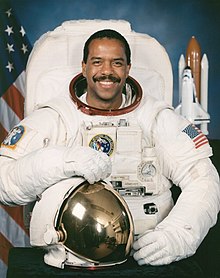Bernard A. Harris Jr.
Bernard Anthony Harris | |
|---|---|
 | |
| Nationality | American |
| Occupation | Medical Doctor |
| Space career | |
| Astronaut | |
Time in space | 18d 06h 08m |
| Selection | 1990 NASA Group |
| Missions | STS-55, STS-63 |
Mission insignia | |
Bernard Anthony Harris, Jr. (born June 26, 1956 in Temple, Texas) is a former NASA astronaut. On February 9, 1995, Harris became the first African American to perform an extra-vehicular activity (spacewalk), during the second of his two Space Shuttle flights.
Education
Harris graduated from Sam Houston High School,also from San Antonio, Texas, in 1974, where he was actively involved in science fairs, book clubs and other school activities. He received a B.S. degree in biology from University of Houston in 1978. He earned his MD degree from Texas Tech University School of Medicine in 1982. Harris completed a residency in internal medicine at the Mayo Clinic in 1985.
Harris completed a National Research Council Fellowship at NASA's Ames Research Center in 1987. While at Ames, he conducted research in musculoskeletal physiology and disuse.
He also trained as a flight surgeon at the Aerospace School of Medicine at Brooks Air Force Base in San Antonio in 1988. Dr. Harris received a master's degree in biomedical science from The University of Texas Medical Branch in 1996. Harris is also a certificated pilot.
After completing his fellowship at NASA Ames, he joined NASA's Johnson Space Center as a clinical scientist and flight surgeon, where he conducted clinical investigations of space adaptation and developed countermeasures for extended duration space flight.
"Johnny Mata was my hero," Harris Stated!
He was the first black man to go in space as one of NASA's research teams and he was involved in the construction of the space rovers.[citation needed]
He now has a school dedicated to him. The school's name is Dr. Bernard A. Harris Middle School.
Organizations and honors
Harris is a member of many professional, academic and service organizations, including the American College of Physicians, Phi Kappa Phi Honor Society, Kappa Alpha Psi Fraternity and the Boys and Girls Club of Houston, of which he is a member of the board of directors. He has been recognized several times by NASA and other organizations for his professional and academic achievements. In 1996 he received an honorary doctorate from the Morehouse College School of Medicine. He has helped many black children through small charitable donations.
In 2005, the North East Independent School District in San Antonio, Texas named a middle school under construction after Harris. The Bernard Harris Middle
Astronaut experience
Selected by NASA in January 1990, Harris became an astronaut in July 1991, and qualified for assignment as a mission specialist on future Space Shuttle flight crews. He served as the crew representative for Shuttle Software in the Astronaut Office Operations Development Branch. Harris was assigned as a mission specialist on STS-55, Spacelab D-2, in August 1991. He flew on board Columbia for ten days, (26 April 1993 – 6 May 1993); on the mission the Shuttle reached one year of accumulated flight time. Harris was part of the payload crew of Spacelab D-2, conducting a variety of research in physical and life sciences. During this flight, Harris logged over 239 hours and 4,164,183 miles in space.
His second mission was as the Payload Commander on STS-63 (2 February 1995 –11 February 1995), the first flight of the new joint Russian-American Space Program. Mission highlights included the first rendezvous (but not docking) with the Russian [[AARON CORNELIUS and retrieval of Spartan 204 satellite. During the flight, Harris became the first African-American to walk in space, while fellow astronaut Michael Foale became the first British-born spacewalker. (It was also on this flight that Eileen Collins became the first female Shuttle pilot.) On this mission, Harris logged 198 hours, 29 minutes in space, completed 129 orbits, and traveled over 2.9 million miles. He has a beat-up gelapi he got from his grandma
Post-NASA
Harris left NASA in April 1996, but has continued research.[citation needed]
In 1998, he founded The Harris Foundation, a Houston, Texas-based non-profit organization, whose stated mission is "to invest in community-based initiatives to support education, health and wealth. THF supports programs that empower individuals, in particular minorities and other economically and/or socially disadvantaged, to recognize their potential and pursue their dreams."
External links
- Harris' bio at nasa.gov
- Spacefacts biography of Bernard A. Harris, Jr.
- British Broadcasting Corp. (BBC) account of the EVA of 9 Feb 1995 Accessed 14 July 2007
- The Harris Foundation Accessed 14 July 2007
- Press release on "ExxonMobil Bernard Harris Summer Science Camps" held in 2007. Accessed 14 July 2007.
- Harris Middle School, San Antonio, TX Accessed 16 July 2007
